Animal husbandry and livestock sectors are critical for the country’s rural livelihood and economic development. India possesses one of the world’s largest livestock wealth; the livestock sector contributes a quarter of the agricultural gross domestic product. Among the livestock species, pig finds an important place as socio-economically weaker sections of society are rearing them.
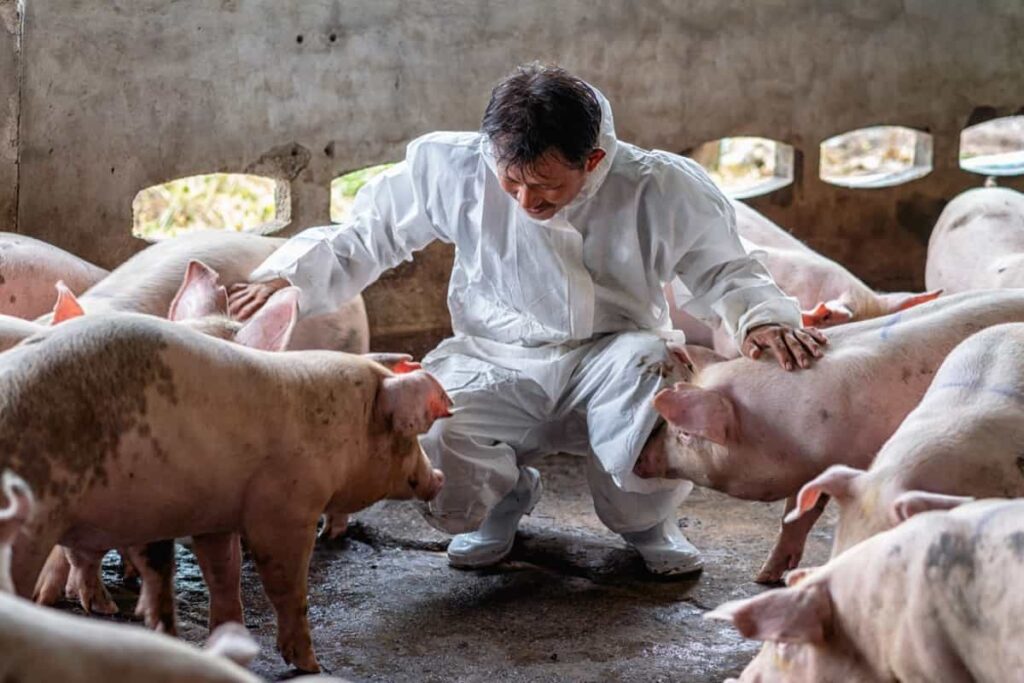
Compared to other livestock species, a pig has a great potential to contribute to faster economic returns to the farmers because of certain inherent traits like high fecundity, better-feed conversion efficiency, early maturity, and short generation interval. Pig farming also requires small investments in buildings and types of equipment. It has immense potential to ensure nutritional and economic security for the weaker sections of society.
In India, 70% of the pig population is reared under a traditional smallholder, low-input demand-driven production system, except for a limited number of semi-commercial pig farms in Kerala, Punjab, and Goa. The typical production system consists of a simple pigsty, and feeding comprises locally available grains, vegetables, agricultural by-products, and kitchen waste.
How to Start Sustainable Pig Farming
Step to Step Guide for Setting up a Pig Farm
- Before starting a commercial piggery business, you must go through proper training at universities and training centers.
- Next, we need to choose an appropriate piece of land. Pig farming should be based on the availability of essential facilities, such as water, transportation, labor, and veterinary services.
- Build comfortable pig houses and essential equipment to help you run a successful pig farm. You’ll be able to shelter your pigs and protect them against diseases, parasites, and predators in these houses.
- Getting pig breeds is the next step after setting up your farm successfully. Hampshire, Landrace, Duroc, and Yorkshire pig breeds are commonly used in commercial production.
- Pigs must be fed efficiently. Its importance of it cannot be overstated in commercial farming. The nutritional level of the food greatly impacts the growth ratio and health of the pigs.
- The breeding process should be initiated. Breeding pigs is a pretty simple and easy process. The female and male pigs usually weigh 100-120 kilograms when they become ready for breeding at 8 months.
- Ensure that the animal is properly cared for and managed. You should take good care of your animals and protect them from various diseases and health hazards.
- Make sure your products are well-marketed. Since there is a lot of demand for pigs when they reach slaughtering age, you can sell them on the local and international markets.
In case you missed it: How to Grow Pigeon Pea/Red Gram/Toor Dal: Cultivation Practices and Production Management
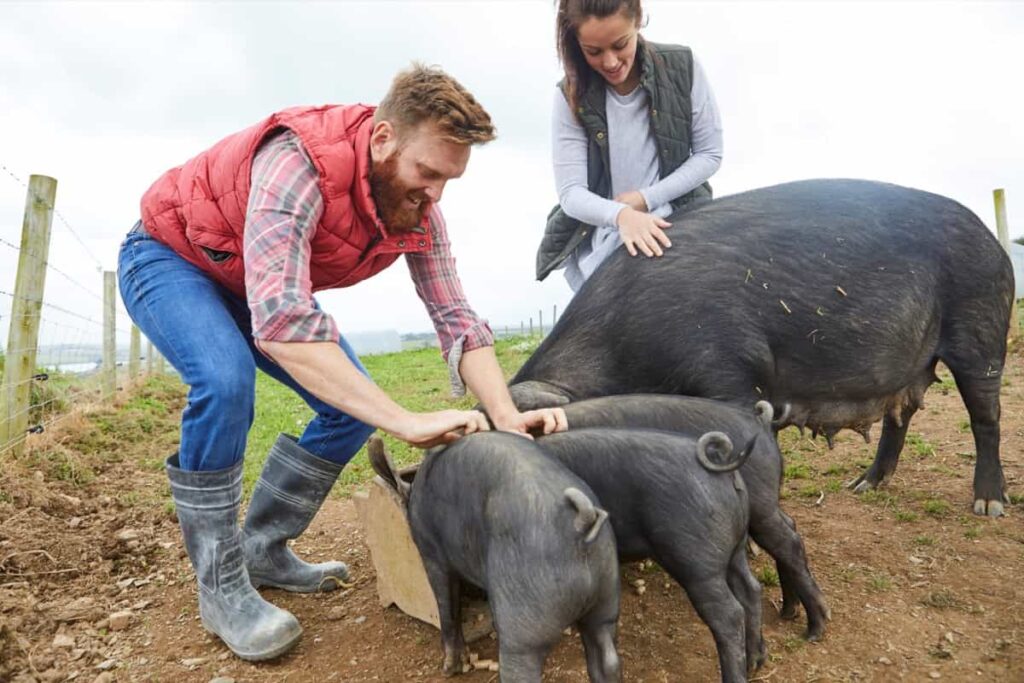
Keeping Pigs in a Field
Tree roots and bushes provide a home for pigs. If the pigs have access to a warm, low area to lie down and sleep in, they will be more comfortable. It is possible to keep pigs in a field where they feed on grasses and plants. Keeping pigs in this way requires a strong fence or wall surrounding the field.
Pigs can push their way out of a field if the fencing is not strong enough. Shelters called pig arks are provided for the animals. Bedding should be contained in these boxes made of wood or metal sheets. It is possible to move the arks to a new spot when necessary.
Housing and Pens for Pigs
Stys, concrete or solid floored pens with low shelters, can be used to house pigs alone or in small groups. The sty should be built in a dry area that is not prone to flooding during the rainy season. The pens should not build too close to houses to avoid unpleasant smells and flies. To ensure that urine flows away from the sleeping area, the floor should be made of concrete that slopes away from the sleeping area. It is important to lay the concrete floor on a good foundation and to make it 5 – 6 cm thick.
In case you missed it: How to Start Pig Farming in Cambodia: Business Plan, Breeds, Cost, Profit, and Management
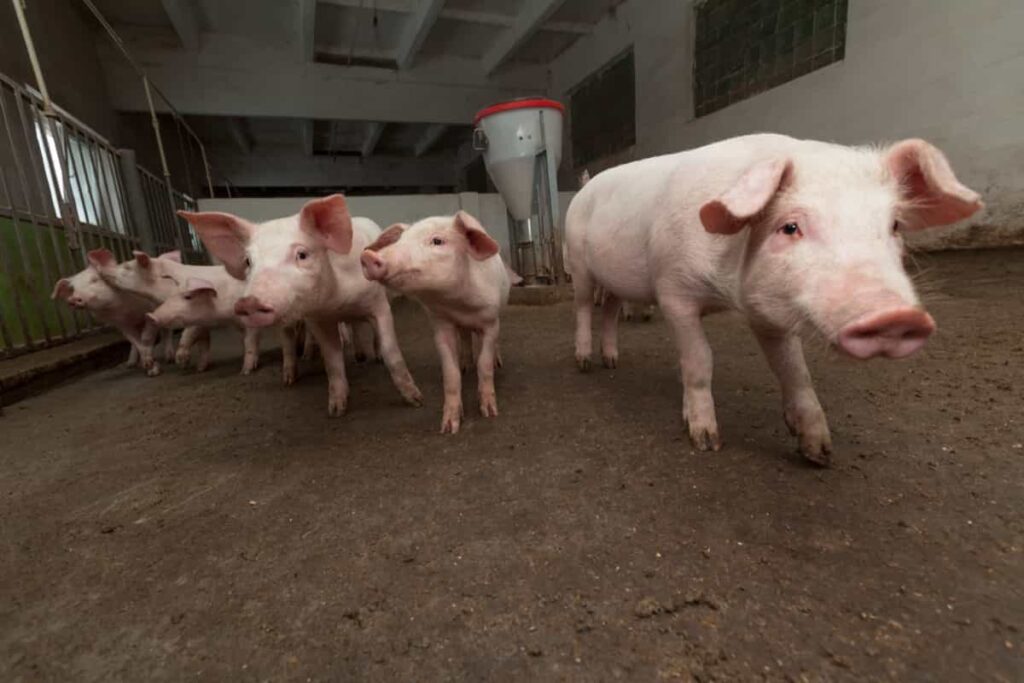
The pigs will soon dig up a thin concrete slab if it cracks. Parasites and other diseases can thrive on an earthen floor because they cannot be kept clean. To keep the walls of the sty clean, they should be fairly smooth. Dirt and germs will accumulate in cracks in the walls. In the shelter, there should be plenty of bedding for the animals. Dung will always be deposited away from pigs’ sleeping and feeding areas. Daily dung removal keeps the pen clean and prevents the buildup of waste and odors.
Housing for Piglets
Sites or open fields can be used to keep breeding sows and their litters. Warm bedding should be provided for young animals, and it should be changed frequently. Having raised a litter in a sty, you should thoroughly clean and scrub the sty after the litter has been weaned and should be shifted elsewhere. The shelter should be shifted to a new site after raising litter in the field to avoid disease problems, especially parasitic worms.
Piglets should get access to a warm area where the sow cannot reach, regardless of the housing method used. Piglets can be fed here and lie down without worrying about the mother lying on top of them. This is called a creep. A temporary wall of strong rails or boards should be placed across part of the shelter to prevent the sow from entering. Approximately 30 cm of the bottom rail is above the ground, making it easy for small piglets to pass underneath.
Weaning Pigs
Piglets are interested in the solid feed when they are 1 or 2 weeks old. The best thing to offer them is a handful of cereal, sugar, or powdered milk. In the first seven weeks of their lives, piglets will drink milk from their mothers. As they wean, they will gradually consume less milk and eat more solid food.
In the field, piglets will naturally begin to eat solid food, but it must be provided in a barn. To prevent digestive problems, young animals need to be gradually introduced to the new feed. Pigs should eat their feed quickly. You will need to examine the animal to determine the cause of ill health if the animal does not show interest in feed.
When and What Type of Feed to Provide to Your Pigs
Pigs are omnivorous, which means they can eat meat and plants. Pigs can also digest bulky feeds containing a great deal of roughage. Fresh, clean water is essential for pigs every day. A pig will eat anything. They will eat grass and all plants. The animals can be kept in a well-fenced field so they can eat all the grass and plants. Besides eating leaves and roots, the pig digs into the ground and eats the green parts of plants.
In case you missed it: How to Care for Your Pigs in the Frost: Cold Management in Pig Farming
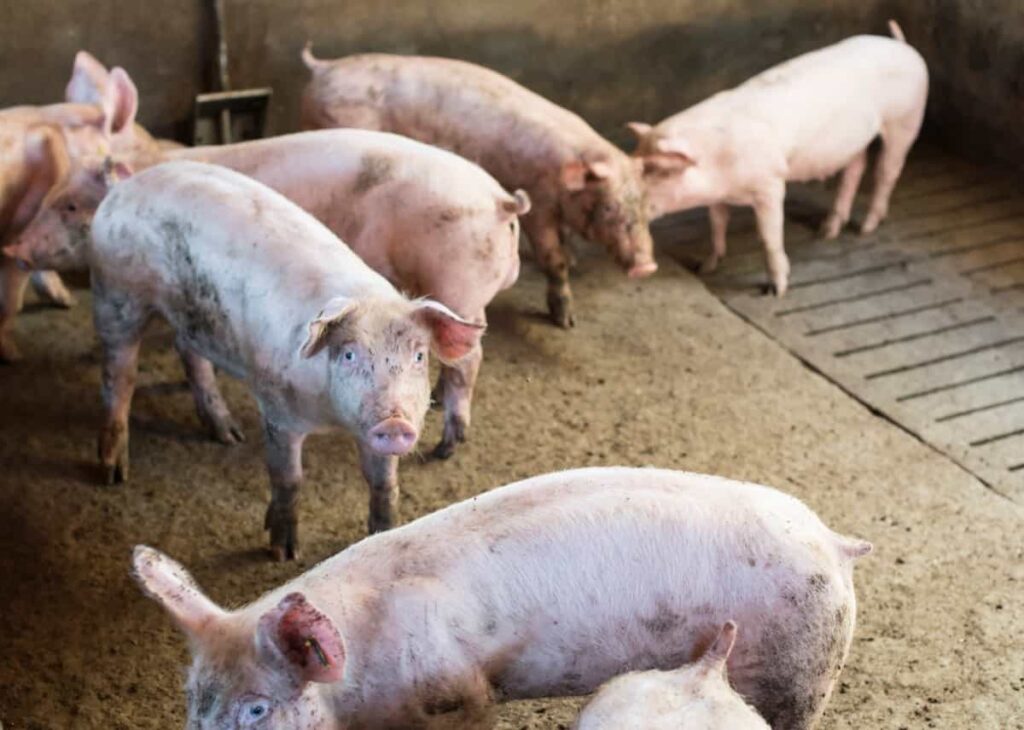
A pig cannot root up plants with a nose ring. A pig can clear, plow, and fertilize a field if it is placed there. Feeding concentrated feed to pigs will result in faster growth and fattening. Feed made from well-ground grain is a good choice. Pigs can also be fed household scraps and waste vegetables. The pig must be given well-boiled household scraps (pig swill) before being given meat scraps.
The pig must have access to fresh, clean water at all times. The daily water requirement of a sow with young is 20 to 30 liters. Two daily feeds are required for pigs kept in a sty, one in the morning and one in the evening. Whenever possible, pigs in the field can be fed once a day or given extra feed, for example, vegetable waste or garbage.
Surrounding Environment Temperature Requirements for Better Pig Growth
The temperature requirements of pigs are crucial for their growth and production. The pig is highly adaptable and can perform well in various climates. However, a very low or high temperature can be detrimental to the stock. Pigs will feed more when the temperatures are cold, but they will spend more energy to keep warm, resulting in slow growth.
Summer heat can cause heat stress and reduce feed consumption (and even death), so keeping livestock cool is crucial. Consequently, growth and maturity rates slow, conception rates decline, and pig flow is reduced, disrupting stock levels. It is important to ensure buildings are well-ventilated or heated and adequate air space is provided within the pens for pigs to grow and produce.
Amount of Water Required for Better Pig Growth
Fresh water should always be available for all pigs (including piglets). It is recommended that the water supply is cool (maximum 18-20°C). The water supply lines should be buried or insulated, especially if they are black poly pipes outside in the sun; otherwise, the water is too hot and unusable.
Water pressure from drinkers should be checked for the age group of pigs if drinkers are used to ensuring they can consume enough water. Piglets and weaners need 0.5 liters/min, growing pigs and dry sows need 1.0 liters/min, and lactating sows need 2.0 liters/min.
In case you missed it: Contract Pig Farming in India: Companies, Agreement, Profits, How it Works and the Pros and Cons
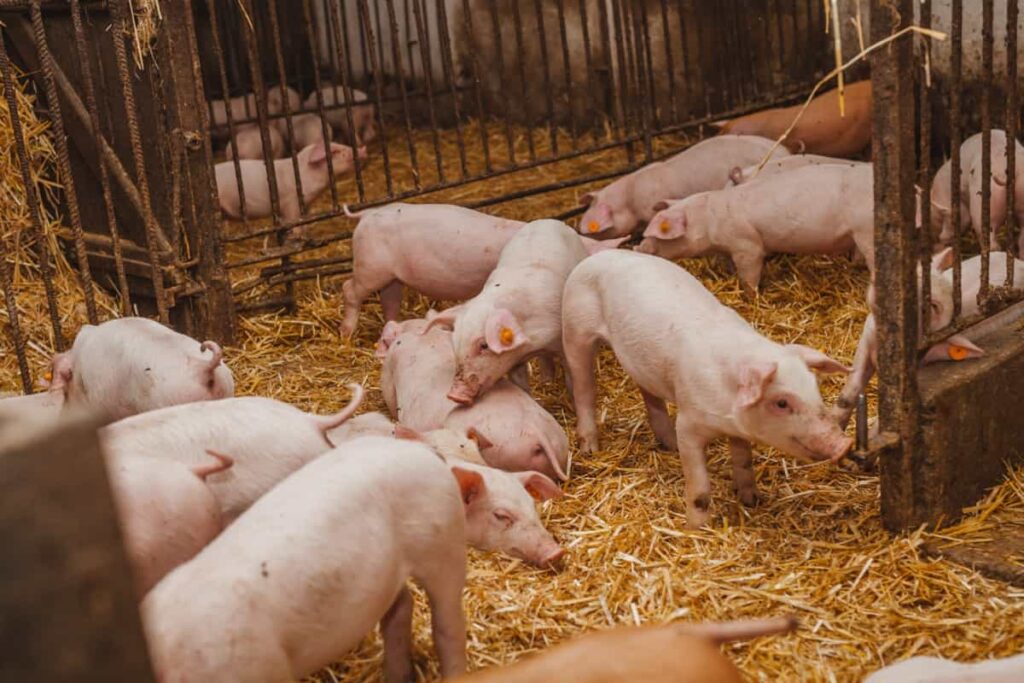
Recommended Flow Rates in Drinkers for Pigs According to Their Age
| Age of pig | Flow rate | Maximum pressure (kPa) |
| Lactating sow | 2 L/minute | No limit (avoid wastage) |
| Dry sows and boar | 1 L/minute | No limit (avoid wastage) |
| Finisher | 1 L/minute | 140-175 |
| Grower | 1 L/minute | 140-175 |
| Weaner | 0.5 L/minute | 85-105 |
Managing Pig Health
- Vaccinations, parasite treatments, and a suitable diet should all be part of a herd health program.
- Pigs should not be fed food scraps or another swill (prohibited pig feed).
- Protect farm dumps from feral pig access by fencing them securely.
- Through appropriate segregation and fencing, ensure feral pigs do not enter domestic or pig facilities.
- For your pigs, only use veterinary medicines prescribed by your veterinarian.
- Ensure you follow all label instructions, including dosage rates, withholding periods, and export slaughter intervals.
- Ensure your pigs are inspected once a day and that healthy pigs are separated from sick ones.
- In case of unexpected illness or death, consult a veterinarian.
- Provide weatherproof shelters. Make sure your pigs are rotated onto fresh pasture (before 60% are grazed) if they are kept in paddocks.
- Maintain clean pigpens and remove manure from paddocks regularly.
- For disease prevention and identification, train staff in biosecurity practices.
In case you missed it: Contract Sheep Farming in India: Companies, Agreement, Profits, How it Works and the Pros and Cons
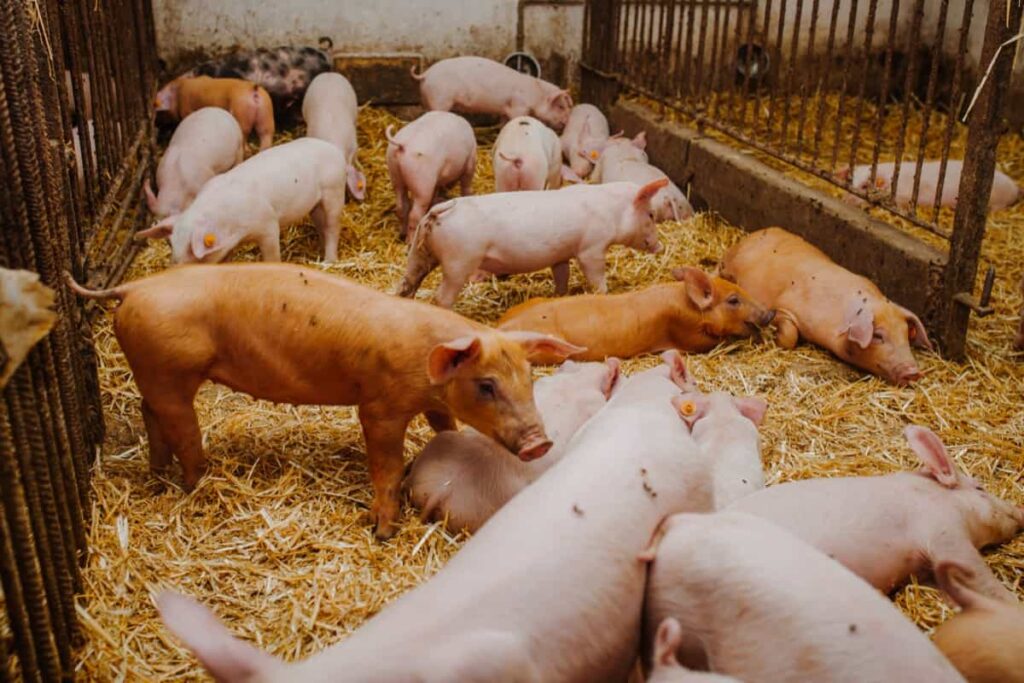
Breeding Pigs
Breeding is an easy process. It is generally accepted that male and female pigs become suitable for breeding within eight months of their birth. During this time, they reach a weight of about 100 to 120 kg. Female pigs are in heat for two to three days during the heat period.
During the heat period of gilts, the first day is the best day to breed. For the sow, the second day is best. When sows are weaned, they are suitable for breeding after 2 to 10 days. A pig’s gestation period is not longer than 115 days. Sows can have 8 to 12 piglets every time they give birth twice a year.
Advantages of Sustainable Pig Farming Over Other Livestock Farming
- Their gestation periods are relatively short so they can produce large litters (young ones). In addition, they have a short generation interval and grow rapidly.
- In terms of meat yield per tonne of live-weight breeding females per year, they are six times more productive than cattle.
- As a result of its more taste buds, the pig can consume anything edible to man and other animals, including bulky food such as grass or hay. It shows that pigs can tolerate a higher level of dietary fiber, allowing them to consume a wider range of feed sources. Due to the high price and scarcity of grains, poultry and pig production in the tropics have been constrained.
- The pig is the most efficient animal at converting kitchen waste into meat, such as leftovers and alternative feedstuffs.
- Pigs produce more carcasses per pound than cattle, sheep, and goats. Furthermore, pig carcasses contain more edible meat and bones.
- Pigs have superior curing qualities and are easier to dress, which makes them more appealing to processors and marketers—for example, ham, bacon, and the like.
- In a properly ventilated and enclosed environment, pigs can adapt easily to most conditions.
- A pig’s feces is rich in nutrients because of the large amount of food they store. Fertilizers can be made from pig feces and recycled into feed for livestock.
In case you missed it: Sustainable Goat Farming: Business Plan, Benefits, and Requirements
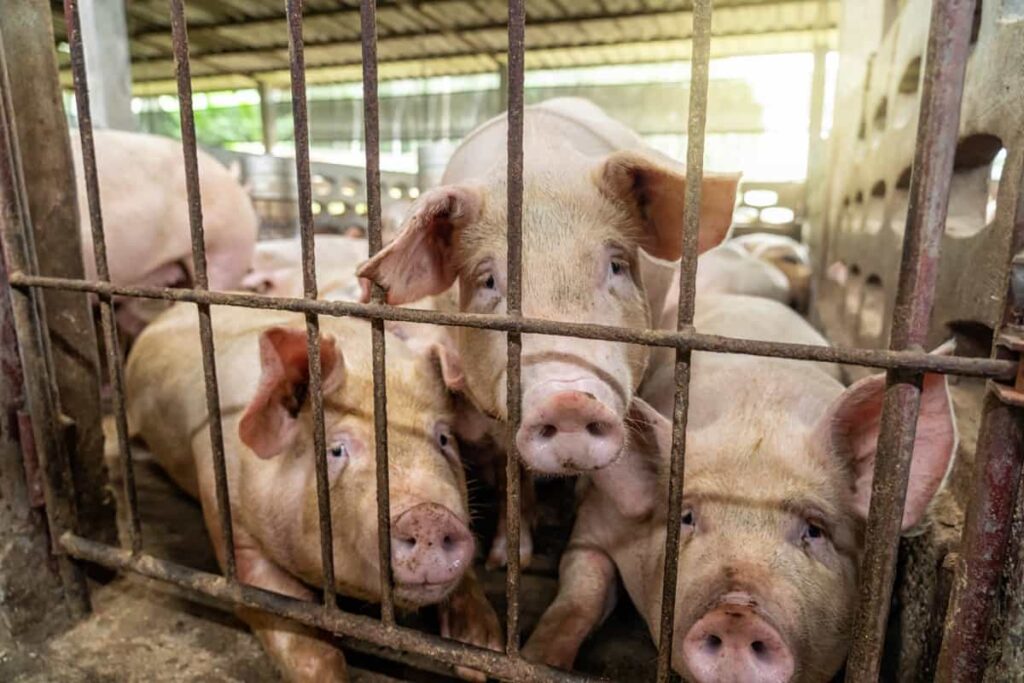
Conclusion
Small and marginal farmers should consider pig farming as a lucrative occupation. It requires a minimum amount of capital investment and labor. There is a rapid and high return on investment. Piglings reach marketable maturity within a very short timeframe. Pig farming in India contributes about 6.7% of the country’s total meat production. The state with the most pigs is Uttar Pradesh, followed by Bihar, Andhra Pradesh, and Tamil Nadu.
- Management Pests and Diseases in Your Cotton Field
- Sheep Farming Business Plan for Beginners
- Aquaponic Farming at Home: A Step-By-Step Guide
- Profitable Village Farming Business Ideas in 2024
- High-Yield Aquaculture: Fast-Growing Fish for Farming
- Effective Fish Pond Construction Techniques for Beginners
- Irrigation and Water Management in Pineapple Farming
- Blossom to Harvest: Mastering Flowering and Pollination in Papaya Farming
- Pig Fattening Essentials: From Selection to Sale for Beginners
- Raising Wagyu Cattle: A Complete Guide for Premium Beef Production
- Soil Types and Their Water Holding Capacity
- Optimizing Irrigation Schedules for Coconut Groves for Enhanced Yield
- Espresso Your Garden: Coffee Grounds for Healthier Acid-Loving Plants
- The Best Soil Mix for Snake Plants: How to Mix Your Own Snake Plant Soil
- Green Thumb Success: Expert Tips for Cultivating Greenhouse Beans All Year Round
- Bloom All Year Round: The Ultimate Guide to Indoor Hyacinth Care
- Eco-Friendly Gardening: How to Make Liquid Fertilizer from Kitchen Waste
- Ultimate Guide to Grow Anise in Pots: Explore Seed Propagation to Harvesting
- Guide to Raising Chester White Pigs: Discover Breed Facts to Growth Management
- Mastering the Elegance: The Ultimate Guide to Weeping Cherry Tree Care, Planting, and Maintenance
- Ultimate Guide to Planting Garlic in Grow Bags: Growing Strategies for Beginners
- How to Fix Spider Plant Leaf-Related Problems: Natural and Organic Remedies
- 10 Reasons Why Your Tulsi Plant is Shedding Leaves: Home Remedies and Solutions
- Optimizing Growth and Yield: The Advantages of Palm Bunch Ash Fertilizer
- Utilizing Neem Oil Extract as a Natural Pesticide for Hydrangea
- From Soil to Harvest: Various Ways in Which Farmers Can Use AI Tools
- Steps to Encourage and Induce Citrus Flowers: A Comprehensive Guide
- How to Fix Snake Plant Leaf-Related Issues: Natural and Organic Remedies
- Transform Your Garden into a Fragrant Oasis with Raat Ki Rani (Night Blooming Jasmine)
- Discover the Ideal Chicken Breeds for Philippine Farms
- How to Create a Poultry Egg Farm Business Plan for Profits
- Grow Lemon Cucumbers Like a Pro: Insider Techniques for Bountiful Yields
- Ultimate Guide to Caring for Your Pink Princess Philodendron: Tips for Thriving Variegation
- Areca Nut Profit Per Acre: Calculating Yield and Cost of Cultivation
- How Kaveri Chicken is Becoming a More Profitable Breed in Indian Backyards
- Transform Your Barn: 9 Steps to Convert a Horse Stall into a Chicken Coop
